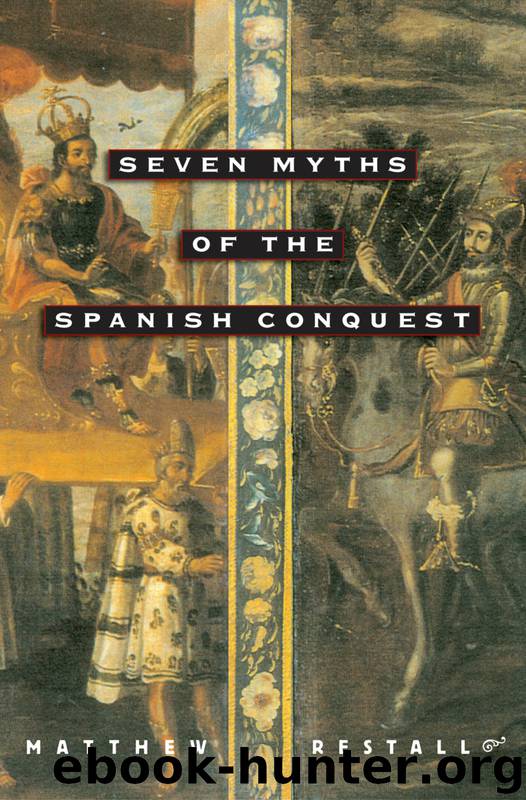Seven Myths of the Spanish Conquest by Restall Matthew;

Author:Restall, Matthew;
Language: eng
Format: epub
Publisher: Oxford University Press
Published: 2003-11-19T05:00:00+00:00
In 1539, Jerusalem was attacked by three Christian armies at once. One was an imperial force led by Charles V, Holy Roman Emperor and king of Spain, accompanied by his brother, the king of Hungary, and French king Francis I. This army had come as reinforcements for a separate Spanish army led by the Count of Benavente. The third attacking force was the army of New Spain, led by Viceroy Mendoza. The battle raged for hours, until the Muslim defenders of Jerusalem finally capitulated. Their leader, “the Great Sultan of Babylon and Tetrarch of Jerusalem,” was none other than “the Marqués del Valle, Hernando Cortés.”
This battle did not actually take place in the Middle East, but in the vast central plaza of Tlaxcala, the Nahua city-state whose alliance with Cortés had proved crucial to his defeat of the Mexica empire almost two decades earlier. The mock battle, part of a day-long series of plays and battles, was staged on Corpus Christi day by the Tlaxcalans, with the possible assistance of Franciscan friars. One of the friars witnessed the spectacle and wrote an account of it, published soon after in Motolinía’s History of the Indians of New Spain.62
While a mock battle in which the victorious armies are led by the Spanish king, the colonial Mexican viceroy, and a Spanish count prominent in colonial Mexican affairs might seem to be a celebration of the Spanish Conquest of Mexico, Tlaxcala’s theatrical “Conquest of Jerusalem” was hardly that. Cortés (played by a native Tlaxcalan actor) was not the victor in the drama, but the Sultan, doomed to defeat—and the captain general of the Moors was Pedro de Alvarado, the second most prominent Spaniard in the fall of Tenochtitlán and the subsequent conqueror of highland Guatemala. As the losers, Cortés and Alvarado requested mercy and baptism, and admitted that they were the “natural vassals” of the Tlaxcalan-played Charles V—an interesting inversion of the conquistadors’ claim that natives were naturally subject to Spaniards.63 As possible insurance against Cortés’s reacting negatively to his role in the play, the Tlaxcalans had the army of New Spain led by a Tlaxcalan playing the viceroy, don Antonio de Mendoza, with whom Cortés was in dispute in 1539 (resulting in Cortés’s sailing to Spain later that year).64
The parts in the play were all played by Tlaxcalans. It was Tlaxcalan warriors, in their thousands, who took Jerusalem, just as 18 years earlier thousands of them had taken Tenochtitlán. And whereas the Tlaxcalans playing soldiers in the European armies all wore the same bland uniforms, the Tlaxcalans of the army of New Spain dressed as themselves—in the traditional multicolored costumes of the city-state’s warriors, complete with feathered headdresses, “their richest plumage, emblems, and shields” (in the words of the Franciscan observer). The setting for the play was Tlaxcala’s impressive new plaza, the size of four football fields, whose buildings, still under construction, became part of the elaborate scenery. An important aspect of the festival’s political context was Tlaxcala’s age-old rivalry with the Mexica,
Download
This site does not store any files on its server. We only index and link to content provided by other sites. Please contact the content providers to delete copyright contents if any and email us, we'll remove relevant links or contents immediately.
| Africa | Americas |
| Arctic & Antarctica | Asia |
| Australia & Oceania | Europe |
| Middle East | Russia |
| United States | World |
| Ancient Civilizations | Military |
| Historical Study & Educational Resources |
Room 212 by Kate Stewart(4969)
The Crown by Robert Lacey(4695)
Endurance: Shackleton's Incredible Voyage by Alfred Lansing(4635)
The Iron Duke by The Iron Duke(4258)
The Rape of Nanking by Iris Chang(4108)
Joan of Arc by Mary Gordon(3987)
Killing England by Bill O'Reilly(3931)
Say Nothing by Patrick Radden Keefe(3851)
I'll Give You the Sun by Jandy Nelson(3335)
Shadow of Night by Deborah Harkness(3268)
Hitler's Monsters by Eric Kurlander(3245)
Mary, Queen of Scots, and the Murder of Lord Darnley by Alison Weir(3126)
Blood and Sand by Alex Von Tunzelmann(3106)
Darkest Hour by Anthony McCarten(3043)
Eleanor & Park by Rainbow Rowell(3013)
Margaret Thatcher: The Autobiography by Thatcher Margaret(3010)
Red Famine: Stalin's War on Ukraine by Anne Applebaum(2849)
Book of Life by Deborah Harkness(2841)
The One Memory of Flora Banks by Emily Barr(2755)
